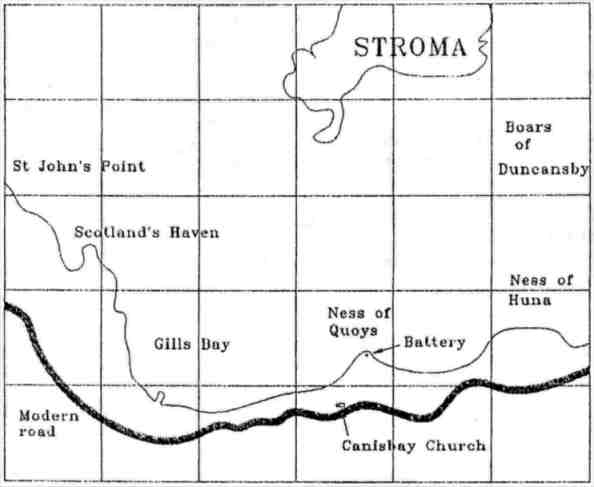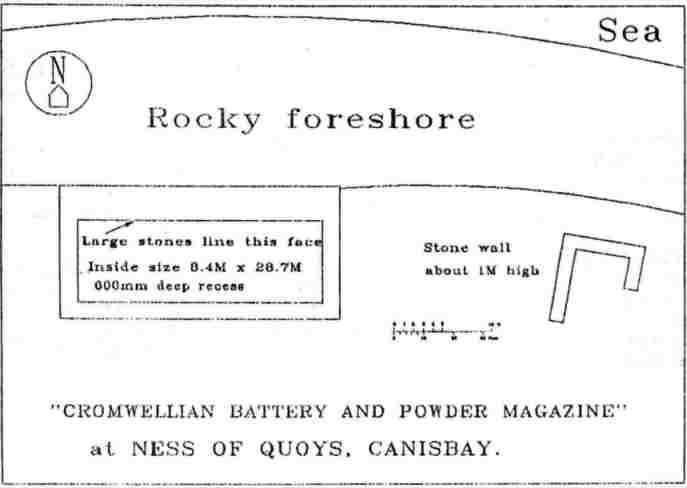|
Caithness Field Club Bulletin 1993 |
|
CROMWELLIAN SOLDIERS IN CANNESBEY, 1652 TO 1655 by Morris Pottinger Everyone in Caithness, of course, knows about Cromwell and the presence of his soldiers in Cannesbey, of the legend that their horses were stabled in the church and his men quartered with the locals. Everyone knows what they were doing in Cannesbey, or do they? Who were Thomas Carre, John Clegge, John Gudelad, James McConile, Glengarrie, Lt. Roy?. What trace still exists of their presence after some 340 years, if any? Well, there is Cromwell's Brig lying in the lee of the John 0' Groat's mill, and not much else. Having studied somewhat the presence and names of Cromwell's men in Orkney, I took a thought as to whether they were recorded in Caithness to any extent, and what trace, if any, we could still find. There just had to be a reason for their presence in Cannesbey for some 4 years and the peaceable parishioners of Cannesbey did not require the presence of "Inglish" troops to keep order in that most distant of parishes. Therefore a look at the map of Caithness was indicated, and indeed that of Scotland, plus a quick look at the history of the times. The Scots were creating trouble, again ! and Montrose had invaded Scotland from Denmark via Orkney and Sannick Bay to meet disaster at Carbiesdale and his death in 1650. It would have been on Cromwell's mind that Scotland needed some form of "Protection" and his troops proceeded northwards, leaving Aberdeen early in 1652 and being recorded in Cannesbey by the 25th of March 1652. They were still getting a mention in 1655 so they were there, off or on, for at least 4 years. So what did they do to keep them in order and under discipline, other than the normal pursuits of the "licentious soldiery". Road making was always the order of the day, and bridge building was but a part of that. Sannick Bay was only a few miles east of Cannesbey so a goodish road along the coast would have been a strategic requirement, including Cromwell's Brig at the Mill. But what else, and why? The main base of Cromwell's men was Ackergill Tower and again a glance at the map of Caithness shows that Ackergill covered Sinclair Bay while Cannesbey covered Sannick Bay to the east of John 0' Groats in Dungasbey and, more particularly, Gills Bay at Cannesbey itself. These were the days of sailing ships dependant on wind and tide and Gills Bay was a lee in which to shelter, waiting for the east-bound flood to change to the west-bound ebb and permit a passage through the Pentland Firth to the west, or to shelter from the all too prevailing west wind against which sailing ships could make but little headway, and against a flood tide, none at all. So where better than Cannesbey to place some troops to either prevent another invasion such as Montrose's recent debacle, or to prevent the French and Dutch, with whom Cromwell was having trouble, from either landing at Gills Bay or using it for shelter against the elements. Having worked all that out, I thought there should therefore be some defensive or offensive works at Cannisbey, if they could be found, justifying the expense of Cromwell keeping troops so far north, and a look at the map indicated a look at the Ness of Quoys covering the eastern approaches to Gills Bay, menacing the channel between Stroma and the mainland, and giving a reason for soldiers being in Cannesbey.
|
|
|
|
Sailing ships would have had to tack back and forth to make a passage against a west wind and each successive tack would have brought the ship close enough to the Ness of Quoys to be within the range of any cannon available, even if their range did not cover all the distance to Stroma. The threat of even a lucky shot dismasting a ship would have deterred in those fiercely tidal streams. Having seen an emplacement in Orkney covering the entrance to Deer Sound, locally credited to Cromwell, and with a very ancient cannon of antique construction still there in place on the Ness of Tankerness, I thought a visit to Cannesbey might bring dividends. So I went there on a sunny Sabbath. And there it was, on the shore, the very visible trace of a rectangular construction, heavily walled on the seaward side, medium walls on either side, and a lighter wall to landward. The surface was level and underlaid with stone but a few inches down, giving the lie to the local suggestion that it was a plantie cru for the growing of cabbages. The beach was composed of very good grey stone easy to build and a gun emplacement of this nature would have had turf and earth banking on the danger side. Some 50 metres to the east was another construction which would have done excellently as a magazine for the storage of gunpowder, again heavily walled to seaward and out of line of shot directed towards the gun battery.
The walls are admittedly very low but after all the passing years would one have expected more? They are still very well defined. From the site, cannon could have covered any approach from the east and it would have been most unwise to try sheltering in Gills Bay. No excavation was attempted, nor would there be without Mr. Dunnet's permission, but I would have liked to try a metal detector over the site, who knows if the odd cannon ball is not still there! I must say this find was very satisfactory as I had calculated on it's being there and was not trying to explain something which I had already seen or found. And there it was. A map drawn by Geoff Leet, shows both scale and location, for which we are much indebted. The only other beach of landing capability on the east of Caithness is Freswick and I have no knowledge or suggestion relating to that save one. There was a Capt. Wood in Freswick in 1655 who had a chyld libbed by a local witch, a "libbe" being a spell spoken over someone ill, and in this case made with small salt. That one reference to Capt. Wood was the only one I found between 1652 and 1666, the name occurring but once. Was Capt. Wood a Cromwellian soldier and was there another detachment covering Freswick Bay from a possible landing from the eastern sea? As for the names of the soldiers and other matters relating to them, it is a part of the history of Cannesbey well worth a glimpse but perhaps outwith a Field Club Study at this time, so for the time being, I will leave you with the thought that Thomas Carre, John Clegge, John Gudlad, James McConile, and others, under the command of Lt. Roy, probably Glengarrie, built the battery still to be seen on the Ness of Quoys, Cannesbey, (old spelling) and to have left to themselves a monument still to be seen on the face of Caithness. |

